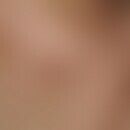Synonym(s)
blastomycosis rhinosporidiotica; Granuloma rhinosporidiosoque; nasal psorospermosis (Localisee); Seeber's disease
HistoryThis section has been translated automatically.
Seeber, 1900
DefinitionThis section has been translated automatically.
Granulomatous infectious disease of the mucous membranes, particularly the nasopharynx, oropharynx, conjunctiva, rectum and external genitalia, caused by Rhinosporidium seeberi, an aquatic protozoon
You might also be interested in
PathogenThis section has been translated automatically.
Rhinosporidium seeberi. The germ could not be cultivated in cultures or inoculated in experimental animals.
Occurrence/EpidemiologyThis section has been translated automatically.
Occurs mainly in tropical and subtropical areas. Sporadically distributed worldwide.
EtiopathogenesisThis section has been translated automatically.
The mode of infection is still unclear, probably a transmission of the spores when bathing in fresh water.
ManifestationThis section has been translated automatically.
Mostly occurring in men.
LocalizationThis section has been translated automatically.
Mainly nose (posterior sections, 70%), also conjunctiva (14%), throat, palate, bronchus, larynx, genital organs.
ClinicThis section has been translated automatically.
Irregularly shaped, brittle, greyish red, slow-growing, broad-based, polyp-like, slightly bleeding growths with small, yellowish-grey spots on the surface (sporangia). Disseminated forms are possible.
HistologyThis section has been translated automatically.
Granulomatous inflammation with neutrophils, histiocytes, plasma cells, microabscesses, giant cells of the Langerhans type. Numerous round cysts surrounded by a lattice shell with numerous nuclei = sporangia (100-400um in diameter) of Rhinosporidium seeberi filled with thawing endospores.
DiagnosisThis section has been translated automatically.
Swab specimen. Microscopic examination.
Differential diagnosisThis section has been translated automatically.
Polyps; condylomata lata; angioma; fibroma; sarcoma; leprosy; tuberculosis; blastomycosis; rhinoscleroma, granuloma teleangiectaticum, leishmaniasis.
TherapyThis section has been translated automatically.
Electrocaustic, surgical removal far in the healthy area. All drug therapies are ineffective so far.
LiteratureThis section has been translated automatically.
- Arseculeratne SN et al (2002) Lymphadenitis, trans-epidermal elimination and unusual histopathology in human rhinosporidiosis. Mycopathologia 153: 57-69
- Delfino D et al (2016) Rhinosporidium seeberi Nuclear Cycle Activities Using Confocal Microscopy.
J Parasitol 102:60-68. - Fredricks DN et al. (2000) Rhinosporidium seeberi: a human pathogen from a novel group of aquatic protistan parasites. Emerg Infect Dis 6: 273-282
- Mr RA (1999) Phylogenetic analysis of Rhinosporidium seeberi's 18S small-subunit ribosomal DNA groups this pathogen among members of the protoctistan Mesomycetozoa clade. J Clin Microbiol 37: 2750-2754
- Lorz M, Heine M (2001) Rhinosporidiosis. A rare cause of nosebleed. HNO 49: 842-844
- Makannavar JH et al (2001) Rhinosporidiosis--a clinicopathological study of 34 cases. Indian J Pathol Microbiol 44: 17-21
- Seeber G (1900) Un nuevo esporozuario parasito del hombre: dos casos encontrados en polipos nasales. Thesis, Universidad Nacional de Buenos Aires
Incoming links (4)
Blastomycosis rhinosporidiotica; Granuloma rhinosporidiosoque; Nasal psorospermosis (localised lake); Seeber's disease;Outgoing links (9)
Angioma; Blastomycosis; Condylomata lata; Cutaneous tuberculosis; Fibroma; Leishmaniasis (overview); Leprosy (overview); Pyogenic granuloma; Rhinosclerosis;Disclaimer
Please ask your physician for a reliable diagnosis. This website is only meant as a reference.







